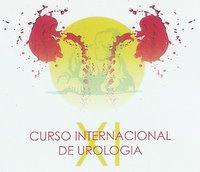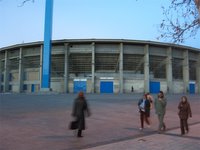 Today I have participated in the Urology International Congress celebrated at the Hospital Miguel Servet, from Zaragoza, organised by profs. Rioja, Liédana y Roncales. It is a very impressive congress, the organization was superb and the scientific program very attractive. Multiple national and international experts were invited. The conference hall had three giant screens where urologists attending the congress could see three simultaneous surgical interventions and hear one of the three conversations going on between the surgeons and the moderators of each surgical session. Congratulations to the organisers!!!.
Today I have participated in the Urology International Congress celebrated at the Hospital Miguel Servet, from Zaragoza, organised by profs. Rioja, Liédana y Roncales. It is a very impressive congress, the organization was superb and the scientific program very attractive. Multiple national and international experts were invited. The conference hall had three giant screens where urologists attending the congress could see three simultaneous surgical interventions and hear one of the three conversations going on between the surgeons and the moderators of each surgical session. Congratulations to the organisers!!!.
 This Hospital Miguel Servet is interestingly in front of the football stadium "La Rosaleda", where the local team scored 6 goals to Real Madrid football club, who could one produce one miserable goal. I have had the strange feeling that everybody here looked suspiciously happy and their smiles were probably wider than usual. I am not exactly a football fan, but one perceives these things..... and my team is Real Madrid.
This Hospital Miguel Servet is interestingly in front of the football stadium "La Rosaleda", where the local team scored 6 goals to Real Madrid football club, who could one produce one miserable goal. I have had the strange feeling that everybody here looked suspiciously happy and their smiles were probably wider than usual. I am not exactly a football fan, but one perceives these things..... and my team is Real Madrid.
My contribution to this scientific meeting was to perform a live PVP (Photoselective Vaporization of the Prostate). The patient was relatively young, and suffered Benign Prostatic Hyperplasia, and although the prostate was small, weighing 44 g, it caused him bothersome symptoms. After visiting him in the Hospital room and chatting for some time explaining the operation and what to expect in the postoperative period, I went down to the surgical theatre. They were operating another BPH patient with a monopolar electrosurgical unit. Monopolar resection is a sophistication of the instrument used for the classic transurethral resection of the prostate (TURP) it allows better cutting and apparently a shorter catheterisation time for patients. It uses saline as irrigant, and this avoids the TURP syndrom (absoption of irrigant into the bloodstream, and dylutional hyponatremia) that can happen when a solution with glycine is used as irrigant. But coagulation is less than perfect, and the patient bleeds during surgery. When they finished, a catheter was inserted and a traction was devised to diminish postoperative blood loss, they said the catheter would stay in for a couple of days. Then it was my turn. The PVP operation was uneventful and I was able to vaporise BPH tissue and reach the capsule of the prostate in just 45 minutes. During the operation, I had a microphone that allowed me to explain the operation and I also had an interesting conversation with the moderator, Dr. Miñana, who posed very interesting questions. I tried to summarize the advantages of this technique as well as the mechanisms of laser and tissue interactions. The audience was very impressed, specially after having seen a monopolar resection, which did not avoid bleeding.
Then it was my turn. The PVP operation was uneventful and I was able to vaporise BPH tissue and reach the capsule of the prostate in just 45 minutes. During the operation, I had a microphone that allowed me to explain the operation and I also had an interesting conversation with the moderator, Dr. Miñana, who posed very interesting questions. I tried to summarize the advantages of this technique as well as the mechanisms of laser and tissue interactions. The audience was very impressed, specially after having seen a monopolar resection, which did not avoid bleeding.
The patient did not bleed at all, and he told me he was happy when he was being carried to the ward, as he had heard all my explanations during surgery. I asked the urologists who will do the follow up to pull his catheter out six hours after surgery and told them that he could be sent home later that day if they wanted. Each time I do this operation I get more convinced that PVP is superior to any kind of prostatic resection, be it with a bipolar or a monopolar generator.
After the succesful surgical session, I went to a local restaurant and then took the AVE (the high speed train) towards Madrid hoping to get some rest tonight.
Thursday, February 09, 2006
Live surgery at the International Congress in Zaragoza
Published by
Fernando Gómez Sancha
on
10:52 PM
![]()
Subscribe to:
Post Comments (Atom)





No comments:
Post a Comment